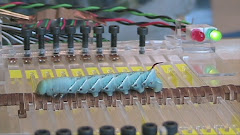I have been trying to write a new post with real scientific materials in the past two weeks. Frankly, it was very difficult to decide where to start after such a long break. In any case, I finally decided to start with a literature review about acoustics in caterpillars.
Yes, some caterpillars do make sounds and use acoustics for communications. Sounds are essentially mechanical vibrations transmitted via some medium. Any organism capable of creating vibration has the potential to transmit information acoustically. In recent years, acoustic communication has become one of the hot topics among the caterpillar biologists. We know that soft tissues are extremely good at absorbing vibrations. How do caterpillars make a sound with such soft bodies?
Well, there are a number of rigid parts in caterpillars where significant vibration can be generated. For example, the mandibles (the mouthparts) are made of tanned cuticle (chitin composite). They can be as hard as some aluminum or carbon-fiber reinforced polymers (Vincent 2004). To signal territory, cherry leaf roller caterpillars (Caloptilia serotinella) scrap their mandibles across the leaf surface to create vibrations on the leaf. Sometimes, plucking the leaf would be sufficient to generate the vibration. These behaviors are observed more frequently when a conspecific (another caterpillar) stumbles onto the leaf roll (Fletcher et al 2006). Some direct body vibration was observed in these caterpillars but with much rare occurrence. Most acoustic signals are still generated by working the hard mandibles against the substrate.
Alternatively, caterpillars can drag their rear ends across the leaf to produce vibrations. Yes, “anal scraping ” is the technical term used in the original literature that reports this behavior (Yack et al 2001). As much as it sounds indignant for the caterpillars, the methodology is quite effective. Larvae of the hook-tip moth (Drepana arcuata) develop a pair of modified oar-like setae instead on their anal segments (they do not have terminal prolegs). These stiff “anal oars” are less than half a millimeter and bit into the leaf as the animal drag the anal segment across the leaf surface to produce relatively long and audible noise (Bowen et al 2008). Such adaptation has been observed exclusively in the family Drepanae, and it can be shown that the anal oars are derived morphologies in these small leaf-rollers as a special adaptation (Scott et al 2010).
The acoustics in caterpillars continue to make headlines. In February, the Journal of Experimental Biology features a research article reporting whistling behaviors in caterpillars. Again this is not a metaphoric description but an illustrative one. Caterpillars of the North American walnut sphinx (Amorpha juglandis) can produce sounds by expiring forcefully through the spiracles (caterpillar’s air valves) (Bura et al 2011). When a caterpillar contracts forcefully, the body compression can squeeze air out of the tracheal system. I reported this phenomenon in one of my earlier posts as I put crawling caterpillars under water. In the walnut sphinx, however, the spiracles of the anal segment are elongated to produce wider lips for whistling. The caterpillar produces three types of audible acoustic signals in response to simulated predation and effectively startles an attacking bird.
The diverse morphologies and behaviors of caterpillars continue to amaze biologists in different contexts. For caterpillars that are vocal, they certainly have expanded their abilities to relay signals important for survival.
Caterpillars, make some noise!!
References
Bowen, J. L., Mahony, S. J., Mason, A. C. and Yack, J. E. (2008). Vibration‐mediated Territoriality in the Warty Birch Caterpillar Drepana Bilineata. Physiol. Entomol. 33, 238-250.
Bura, V. L., Rohwer, V. G., Martin, P. R. and Yack, J. E. (2011). Whistling in Caterpillars (Amorpha Juglandis, Bombycoidea): Sound-Producing Mechanism and Function. J. Exp. Biol. 214, 30-37.
Fletcher, L. E., Yack, J. E., Fitzgerald, T. D. and Hoy, R. R. (2006). Vibrational Communication in the Cherry Leaf Roller Caterpillar Caloptilia Serotinella (Gracillarioidea: Gracillariidae). J. Insect Behav. 19, 1-18.
Scott, J. L., Kawahara, A. Y., Skevington, J. H., Yen, S. H., Sami, A., Smith, M. L. and Yack, J. E. (2010). The Evolutionary Origins of Ritualized Acoustic Signals in Caterpillars. Nature Communications 1, 1-9.
Vincent, J. F. V. and Wegst,U.G.K. (2004). Design and Mechanical Properties of Insect Cuticle. Arthropod Struct.Dev. 33, 187-199.
Yack, J. E., Smith, M. L. and Weatherhead, P. J. (2001). Caterpillar Talk: Acoustically Mediated Territoriality in Larval Lepidoptera. Proc. Natl. Acad. Sci. U. S. A. 98, 11371.

.jpg)
No comments:
Post a Comment